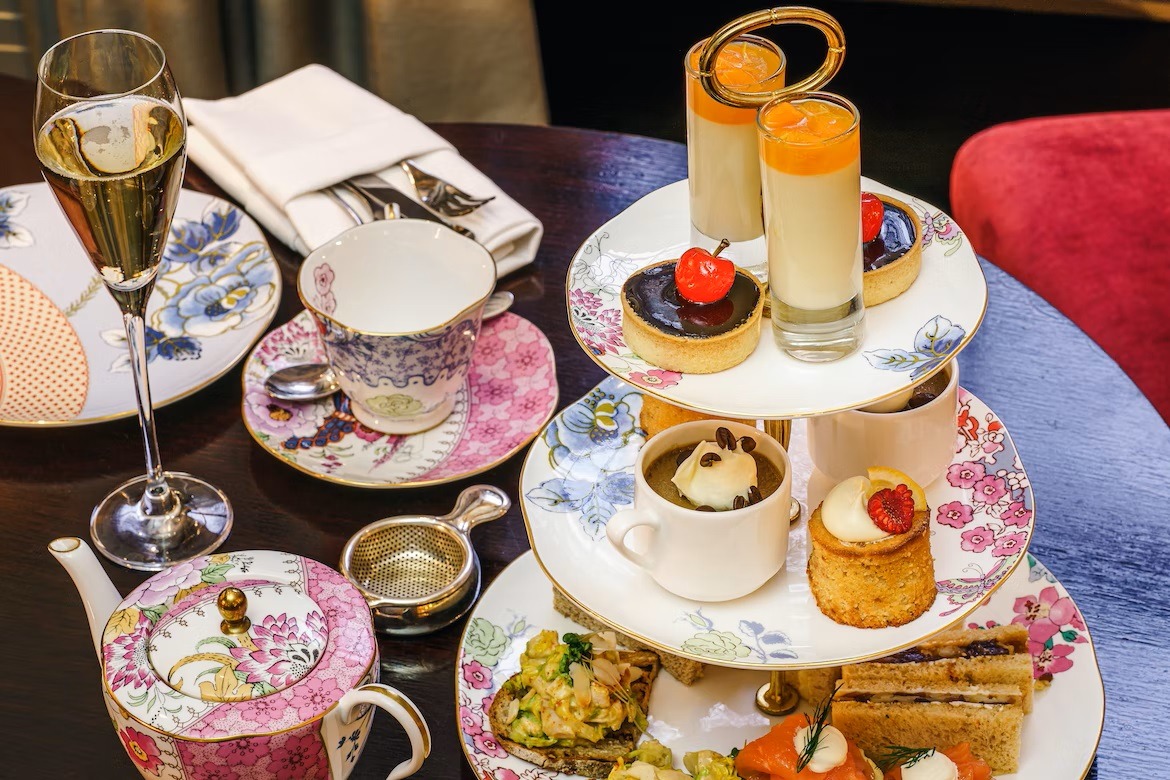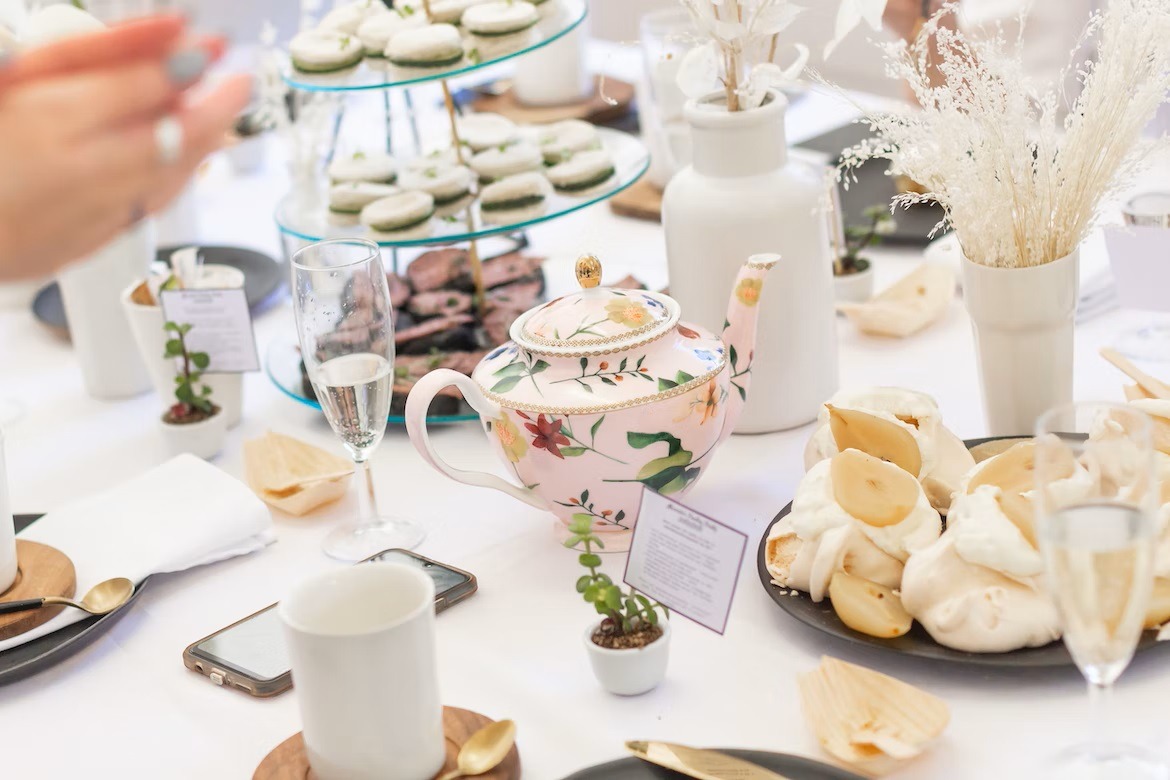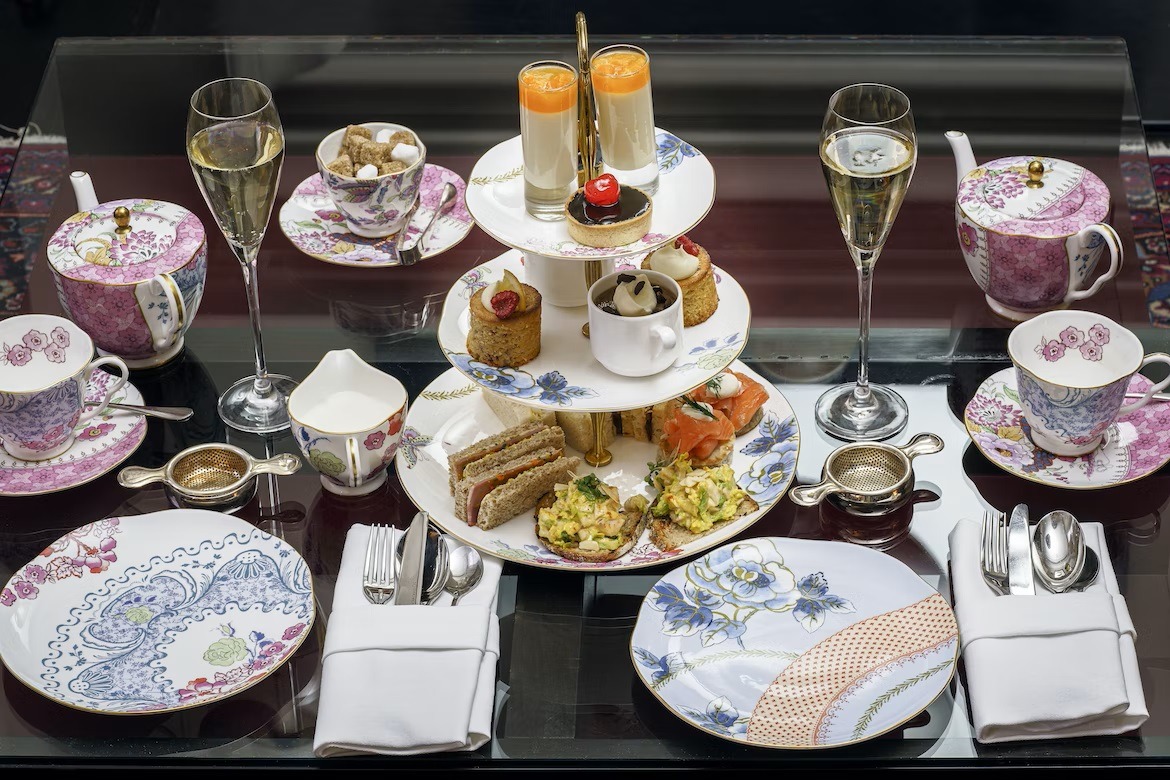Afternoon tea paired with champagne is commonly referred to as champagne tea and is also known as “Royal Tea.” Like afternoon tea, royal tea includes sandwiches, scones, sweet pastries, steaming cups of traditional tea, and glasses of champagne or other sparkling beverages like prosecco. Afternoon tea is occasionally served with iced tea, drinks, or cocktails that include tea in them.
The meal known as afternoon tea is called “Royal Afternoon Tea” when a glass of champagne is included. Afternoon tea is referred to as “Sparkling Afternoon Tea” when a glass of prosecco, cava, or sparkling wine is included.
Royal Tea Etiquette
Royal tea is a formal event, and there are certain rules of tea etiquette that must be followed, like:
- never over-stirring your tea
- always set the saucer down on the table
- depending on whether you are right- or left-handed, the teacup handle points to either 3 or 9 o’clock
- the scones with thick clotted cream and jam are eaten after the bottom
- savory layer while they are still warm
- the petit fours are then savored
- you are required to take each thing and set it on your smaller plate using utensils
- there is no need for utensils when consuming sandwiches and scones
When should champagned be served?
The champagne would be served first as a welcome beverage when guests arrived, and the host could take care of any last-minute culinary preparations if it is held at home. When enjoying royal tea at a hotel or tea parlor, you may choose the time that works best for you. Both at the start and the end. The sort of champagne will determine if it is appropriate to serve with the pastry course.
Best time for Royal Tea
The optimum time to offer royal tea is in the afternoon. It is intended to fill the time between supper and lunch. Typically, royal tea is served between 3 and 5 o’clock in the afternoon. Because many people like to have a very satisfying royal tea as a replacement for lunch or as an option for supper, many tea shops, restaurants, and hotels provide royal tea from noon till dinner time.
What to wear during Royal Tea?
Before you arrive, it is crucial to confirm that the place you reserved has no formal attire requirements. One hotel in London requires men to wear ties and jackets and will not let them in without them! If it is not stated on the internet, I advise contacting to double-check, particularly at the bigger hotels.
Suggested champagne paired with teatime bites
Some people provide suggestions for the best champagne to combine with afternoon tea, whether you favor cakes and pastries or something savo.
1. Smoked salmon on buttered brown bread or soft prawn rolls
It is suggested that the seafood aficionado sips on a pink-hued rosé champagne. The red berry scents and tastes of this style pair perfectly with oily seafood and shellfish, and they also go well with pastries or cakes made with strawberries and raspberries.
2. Cucumber sandwich with minted cream cheese
For a teatime that is primarily vegetarian, a bottle of zero-dose champagne, often known as “Extra Brut,” is advised. The simple, low-to-no-sugar approach complements the delicate aromas well and allows the veggies’ inherent sweetness to shine through.
3. Egg mayonnaise and cress sandwich
A Blanc de Blancs champagne is advised for more creamy or rich components, especially buttery pastries. A Blanc de Blancs champagne is a crisp, vibrant variety made entirely of chardonnay and distinguished by the tastes and aromas of citrus fruits. Your experience will be balanced by this, which will cut through any possible heaviness and make everything taste far lighter.
4. Coronation chicken or beef pastrami with caramelized onions sandwich
It is suggested that meat lovers select a Blanc de noirs champagne. This is a white champagne made exclusively from pinot noir or Meunier grapes. This technique, which has more structure, provides champagne holding against the strong tastes of the meat. A Blanc de noirs champagne may begin with red fruit tastes, but it also pairs nicely with sweet and savory dishes.
5. Freshly baked scones with strawberry jam and Cornish clotted cream
It is suggested to try a demi-sec champagne with the traditional afternoon tea nibbles. It is more palatable when combined with sweet delicacies while remaining wonderfully fresh.
A secret tip:
Choose vintage champagne in your preferred style if you want to match one exceptional bottle for the entire tea party. Vintage champagnes are matured for at least three years on the lees, but many are aged for much longer, occasionally for up to ten. The wines have time to produce fresh aromas and deeper levels of complexity. On occasion, flavors, and smells of brioche, pastry, butter, and toffee mild tobacco with an earthy flavor, dried fruit, and spice. Your vintage champagne will be the ideal food-pairing star wine for your next teatime because it may be paired with a variety of snacks and entrees.
Health Benefits of Champagne and Sparkling Wine
Key health advantages of champagne and sparkling wine when taken in moderation include:
- Good for spatial awareness and memory: Champagne and sparkling wine include certain proteins that have been found to improve short-term memory. It has been suggested that a person might have a 200% increase in the memory-enhancing protein in their brain after three years of routinely drinking champagne.
- Benefits for the heart: Champagne and Sparkling Wine share the same heart-healthy advantages as red wine because they are primarily derived from red grapes. Additionally, polyphenol antioxidants included in champagne and sparkling wine help to protect the heart by delaying the elimination of nitric acid from circulation, which lowers blood pressure.
- Makes your skin better: Champagne’s polyphenols may help reduce redness, and its carbon dioxide may help tighten your skin.
- Boosts your mood: Champagne and Sparkling Wine will cheer you up if you are a little down. They produce dopamine, the “feel-good” brain chemical that enables you to move about, think positively, and experience pleasure, as well as natural trace components that may improve your mood.
- Can be a digestive aid: You could find that champagne improves meal digestion. Champagne and other fermented alcohols, according to German research, can up the stomach’s acidity by as much as 95%.
- May benefit the brain: Three phenolic acids from Champagne and Sparkling Wine—tyrosol, caffeic acid, and gallic acid—have been shown in research published in the Journal of Agricultural and Food Chemistry to protect the brain from the harm that free radicals may do.
Conclusion
For those extra special occasions, there is a word called “Royal Tea” that refers to adding a glass of champagne to a regular afternoon tea. It can be a fun delight to enjoy with friends or family on special occasions.



